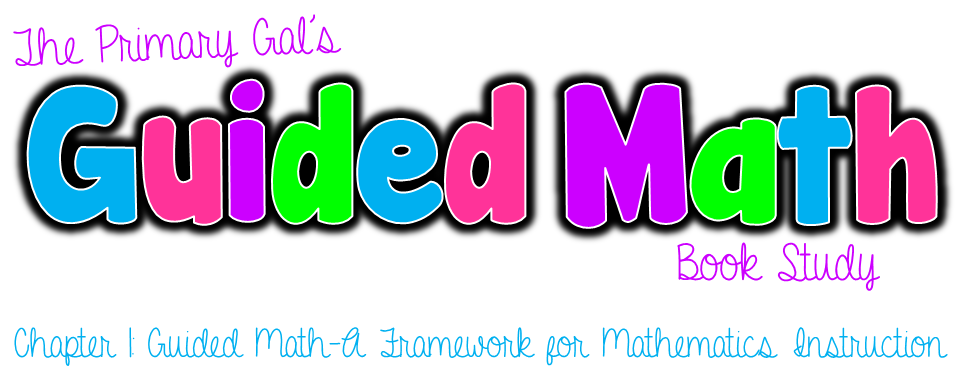Even though school is not out, I am already thinking about next year. I found out that I will be teaching 3rd grade next year and I'm ready for the challenge. With a new grade comes new standards and strategies, and one of the biggest things I want to overhaul is my math instruction.
Enter this book study hosted by The Primary Gal! I have been wanting to read this book since January and I am excited to get started. (Make sure you keep reading to the bottom of this post because there's a giveaway and the links to the other fabulous bloggers that are participating in this book study!!!)
Reflections:
This chapter gives an overview of the need for small group math instruction and the components of the guided math framework. Author Laney Sammons points out that, while literacy instruction has changed dramatically in the last 20 years to a more student centered, small-group model, math instruction has continued to be done in a teacher-center, whole-class way.
Often times, this whole-class method leads to procedural knowledge as opposed to conceptual knowledge. As educators, we've all encounter the kids who can solve problems quickly and accurately, but cannot explain why their strategy works beyond "that's what the teacher said to do". Guided math gives teachers the opportunity to develop students' conceptual knowledge in a meaningful way.
Sammons gives 7 components of her model:
1. A classroom environment of numeracy--create an environment of rich mathematical opportunities, allowing students to engage in real world math problem solving; create a community of learners who are willing to take risks and share their thinking
2. Morning math warm-ups and calendar board activities--set the tone for the mathematical day; oral activities to promote mathematical conversations
3. Whole class instruction--traditional, teacher-directed method of instruction; good for presenting strategies or literature connections
4. Guided math instruction with small groups--assess students then group them according to proficiency levels in a particular skill; allows teachers to work with students to provide support for struggling students and challenges for advanced students
5. Math workshop--students engage in meaningful, independent math activities
6. Individual conferences--one-on-one meetings with students to gain information about their mathematical understanding individually and that of the class as a whole
7. An ongoing system of assessment--use a balanced system of assessments to get a complete picture of students' understanding; includes formative and summative assessments, observations, and student self assessment
This chapter concludes with a menu of instruction and sample weekly schedule. I love that she recognizes that different instructional approaches can be beneficial for different things. She points out that guided math is a framework that enables teachers to use their professional judgement to meet the needs of their students.
While reading this chapter, this quote really stuck out with me: "If it (our understanding) didn't (increase), we comforted ourselves with the knowledge that some people just don't have mathematical minds." I have heard this all through high school and college and even from students who've said that their parents have told them that math just isn't for some people. This was a foreign idea to me as I minored in math in college; I've always loved math. It breaks my heart to hear children say this because math is for everyone. By using the guided math framework, I feel that we'll be able to meet children where they are and guide them to where they need to be.
I feel that I'm currently successful at assessing my students to see what they know before beginning our units of study. I also think that I started using math work stations last year in a way the allowed me to work the a small group while keeping my kids engaged in authentic math activities.
Areas that I'd like to improve on are creating a better environment for math (having a dedicated math focus wall), calendar activities, and planning for small group instruction. I'm sure that by the end of this book I will have picked up excellent strategies for all of these areas.
Now for the giveaway!
a Rafflecopter giveaway
Guided Math Book Study: Chapter 1
Subscribe to:
Post Comments (Atom)








Great first chapter Brandi! I didn't realize that you were moving to 3rd! Wow- you are just moving all over the place :) I think I will need to grab this book- I want to better organize my math instruction :) Thanks!
ReplyDeleteTori